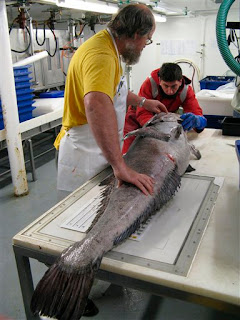
I have indicated how the VIP's that visit Antarctica are shown the same cod, and told the story of fish-born anti-freeze. I wonder if you could take a cod for a ride on a cold day in the ocean? Now more interesting biological information is emerging from Antarctica. But, is the US NSF program involved?
New giant marine species have been found. In fact, people connected with New Zealand's National Institute of Water and Atmospheric Research hope to categorize up to 150 new species of marine life, from these two months of field Antarctic work alone (see StarTribune). The KIWI article says only small scale studies have been performed previously in the Ross Sea area, and so this is a bonanza of new biological information. So, VIP's take note : Years went by and NSF gave you nothing but a fish story in return for the taxpayer's money. All along, there was a bonanza of scientific data available, right where the main US base exists. Ask yourself "Is USAP research being performed honestly?" Meanwhile the Russians have been filling up their boats, probably putting some species out of existence due to over-fishing -- But the USAP program continues on ...
Saturday, March 22, 2008
Happening in Antarctica : A Real Biology Program?
Posted by
StoicOne
at
10:43 AM
0
comments
![]()
![]()
Saturday, March 15, 2008
Happening in Antarctica : Buy a position at Caltech/JPL
 Is it possible to buy a position for someone at CALTECH/JPL? Many people have their applications ignored or rejected. Perhaps when people are bribed for some people to get in, this makes it more difficult for others who are without bribes. You can pay the annual tuition yourself (quite expensive). If your faculty advisor is in the NSF Antarctic Program, however, he can buy someone a graduate position with public money! Why use your own?
Is it possible to buy a position for someone at CALTECH/JPL? Many people have their applications ignored or rejected. Perhaps when people are bribed for some people to get in, this makes it more difficult for others who are without bribes. You can pay the annual tuition yourself (quite expensive). If your faculty advisor is in the NSF Antarctic Program, however, he can buy someone a graduate position with public money! Why use your own?
In Geodynamics/Glaciology, people want to fix the position of points for the sake of mapping and measuring surface deformations. So, say your Ohio State University (OSU) faculty advisor, funded on a Polar Program NSF grant, knows your parents and wants to help you get into the Seismological lab at Caltech. What could he do for you? Well, he cannot just give grant money away to someone. Here's an idea : "How about purchasing a bunch of expensive equipment from the relative of a faculty member at Caltech, with the understanding that the faculty will do a favor for you - like give someone a graduate research assistant position?" Guess how much moola takes to get into Caltech this way?
Well by OSU/Caltech standards in 1985, it required a mere 1.2 million dollars. That is correct! This is what it cost to get the position. The purchase involved 25 or so MX1502 Magnavox doppler geoceivers from an LA company. The geoceivers were used for glaciological research in Antarctica, and approved by Jane Dionne at NSF.
Well, this is nothing new, is it? After all, people will make purchases and one is free to make purchases where one wants. Well, it was known to all investigators that doppler JMR models were available for half the price. Nope, OSU did not want the JMR models. Then people became aware that GPS field units were available or soon to be available. The price for these was approximately the same as the JMR model. Why use doppler geoceivers when you can use the more advanced dual-frequency GPS receivers (available from Trimble in 1985) ? It did not seem to make sense to make this purchase -- of what were actually obsolete satellite receivers -- for twice the price of GPS units. People were wondering : "Why were they purchasing someone's entire inventory of obsolete geoceivers?" The request was made for the MX1502's, and NSF rapidly approved without questioning the purchase, and the deal was done. In two years all the receivers were scrapped and replaced with GPS units.
One OSU undergraduate student got a graduate position at Caltech.
One might wonder if this is the best way to select talent. Well, in a future posting I will examine a typical study done by this person, and you can judge for yourself!
Posted by
StoicOne
at
11:26 PM
0
comments
![]()
![]()



